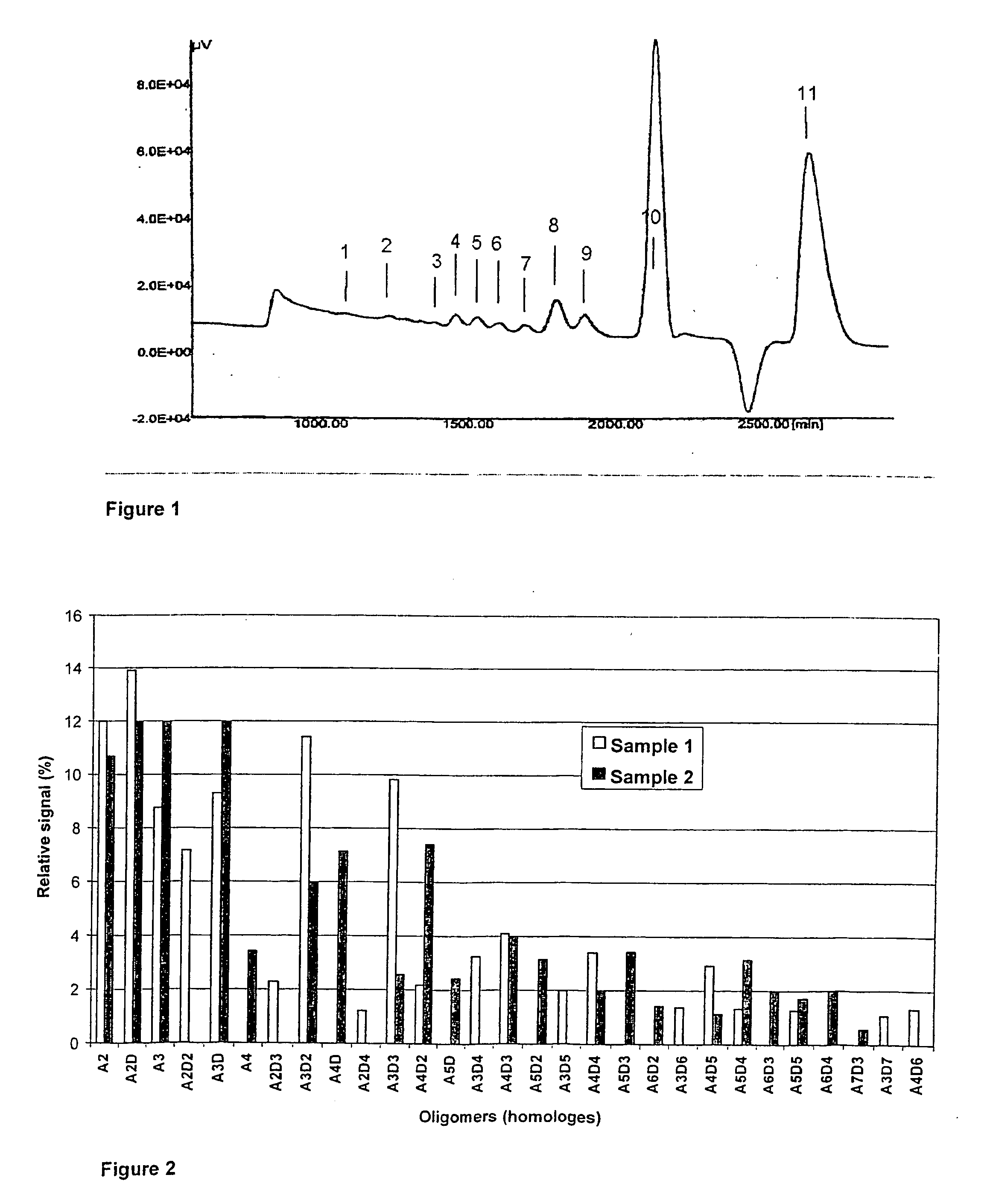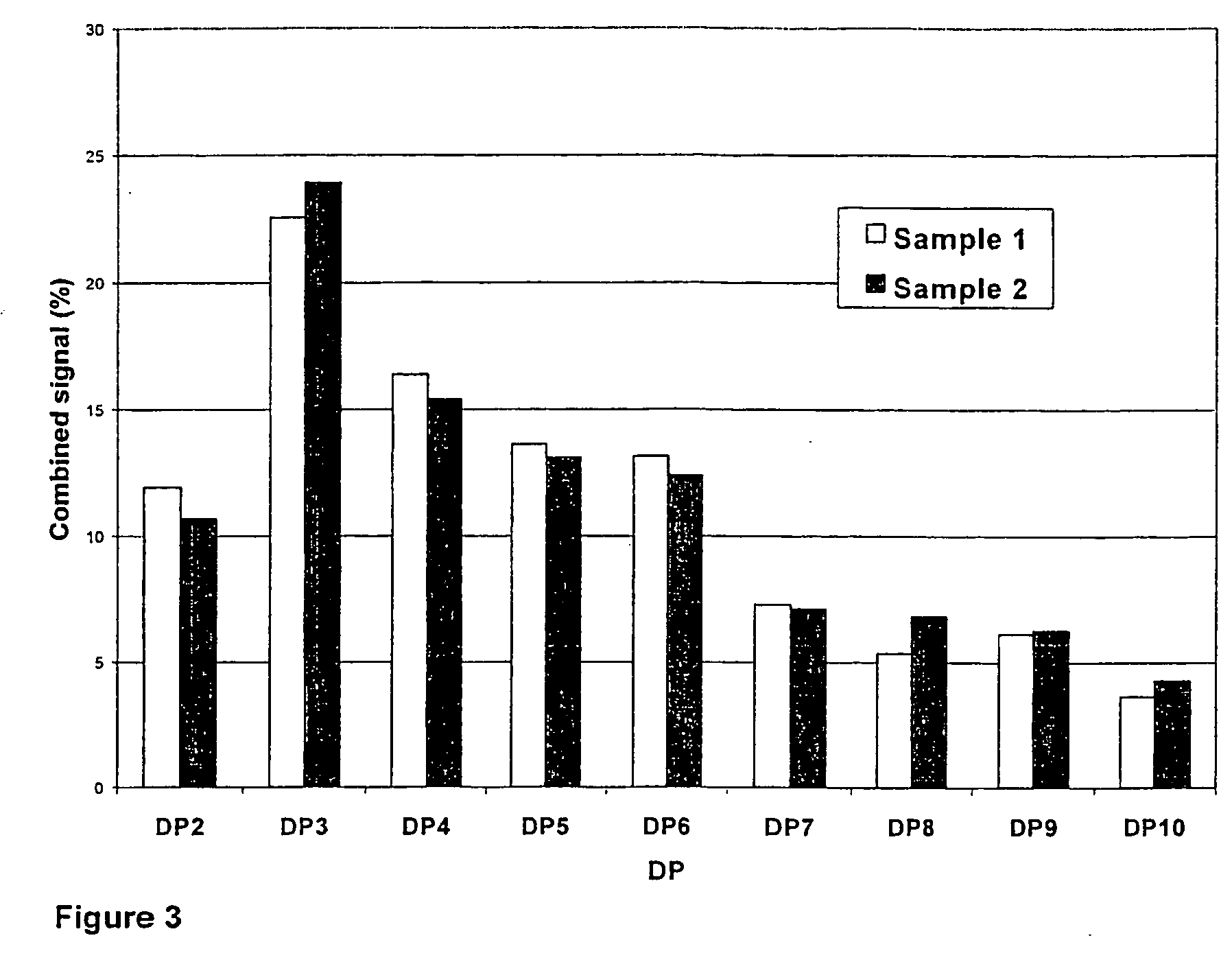Pharmaceutical composition comprising chito-oligomers
a technology of chito-oligomers and pharmaceutical compositions, applied in the field of pharmaceuticals, can solve the problems of increasing swelling, limiting the rate of amino sugar biosynthesis, and severe damage to joints
- Summary
- Abstract
- Description
- Claims
- Application Information
AI Technical Summary
Benefits of technology
Problems solved by technology
Method used
Image
Examples
example 1
Characterization of Chito-Oligomers: Analytical Methods
1A: Determination of Water and Ash Content
A 4-5 g sample of spray-dried chito-oligomers was analysed for water content by gravimetric analysis before and after incubating at 105° C. for 3 hours. Ash content was determined by complete combustion at 800° C. for 3 hours and calculated as percent weight of inorganic residue on a dry weight basis.
1B: Determination of Degree of Deacetylation by Direct Titration
Chito-oligomers (500 mg, moisture and ash corrected) was mixed with 125 ml 0.060 N HCl in a sealed Erlenmeyer flask and dissolved overnight at 22° C. in a rotary shaker (150 rpm). Subsequently, 125 ml distilled water was added and the solution was shaken further for at least 15 min. 50.0 g of the solution were transferred to a beaker and titrated with 0.500 N NaOH solution, using a flow of 1.00 ml / min (HPLC pump). The pH was monitored between pH 1.8 to 9, and the DDA was calculated based on the volume of the NaOH consume...
example 2
Production of Chito-Oligomers (COs) Used for Oral Administration Against Arthritis.
Production of Sample 1 (G000823-1K):
Sodium hydroxide, 25 kg was dissolved in 25 kg of water in a 80 L blender and heated to 70° C. Shrimp chitin (Primex ehf.), 2.5 kg was added and stirred (15 rpm) for 20 min. The slurry was then cooled with water, filtered through a cheese-cloth bag (200×40 cm) and washed for 10-15 minutes. The chitin gel was transferred back into the blender, the pH was adjusted to 4 by addition of 30% HCl, and water was added to give a volume of 80 L. Chitinase solution, 380 g (750 U / g) was added and the gel was stirred for 16 hrs at 30° C. The enzyme was denatured by adjusting the pH to 7 and heating of the solution to 70° C. for 10 min. After cooling, the oligomer solution was poured through a sieve of 280 μm mesh size. The solution was subjected to spray-drying, using a rotary atomizing spray-drying unit at an inlet air temperature of 190° C. and an outlet air temperature of...
example 3
Oral Administration of Chito-Oligomers (COs)
Subjects suffering from arthritis took daily doses of 3.0 g (1 tsp; 5.0 ml, 1223 mg of COs) of Sample 1 spray-dried chito-oligomer powder dissolved in water for at least 5 weeks up to two years. Two of these patients stopped the administration for a 5-6 weeks period after a continuous supplement and then started again taking 2.9 g of Sample 2 (1 tsp; 5.0 ml, 1331 mg of COs).
Results of Administration
Subject 1: Treatment of rheumatoid arthritis
A female subject, age 55 years, was suffering from rheumatoid arthritis. The joints of both hands were severely swollen. The fingers were stiff and their movement caused pain. The subject took 3 g of the Sample 1 chito-oligomer powder daily. The subject noticed a significant improvement after 4 to 5 weeks. There was a remarkable relief of symptoms, inflammation ceased and joints of fingers appeared normal again. There was a relief of pain and the subject could move her fingers more freely, maki...
PUM
| Property | Measurement | Unit |
|---|---|---|
| degree of polymerization | aaaaa | aaaaa |
| molecular mass | aaaaa | aaaaa |
| temperature | aaaaa | aaaaa |
Abstract
Description
Claims
Application Information
 Login to View More
Login to View More - R&D
- Intellectual Property
- Life Sciences
- Materials
- Tech Scout
- Unparalleled Data Quality
- Higher Quality Content
- 60% Fewer Hallucinations
Browse by: Latest US Patents, China's latest patents, Technical Efficacy Thesaurus, Application Domain, Technology Topic, Popular Technical Reports.
© 2025 PatSnap. All rights reserved.Legal|Privacy policy|Modern Slavery Act Transparency Statement|Sitemap|About US| Contact US: help@patsnap.com



